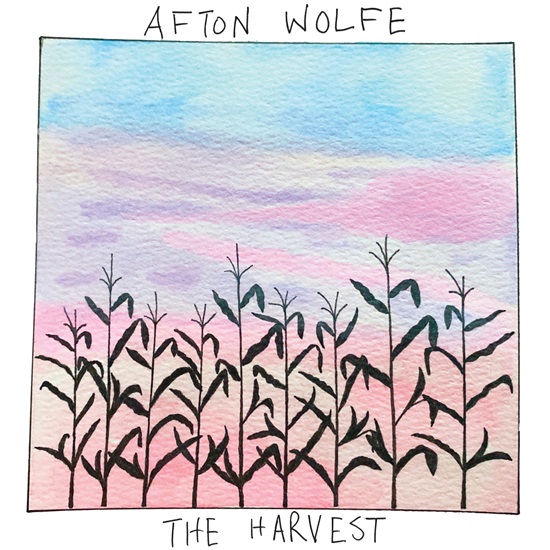
If anything’s predictable about the work of Afton Wolfe it’s the unpredictability. He has such a wide range of references and influences that you never know what’s around the next corner. The first surprise about ‘The Harvest’ is that there are no Afton Wolfe originals. The second surprise is that all of the songs are written by his father-in-law L.H. Halliburton so the album’s all about performance and interpretation of someone else’s songs, bringing all of his influences into play. Afton’s gravelly baritone serves all seven songs on this project perfectly the slightly sinister ‘Hello, Mr. Wolf’ – more about that later.
The album opens with ‘The Harvest’ which bounces along with hints of Van Morrison’s ‘Bright Side of the Road’ to put forward the idea that the year should begin in the fall with the harvest, rather than in spring with the sowing. ‘New Orleans Going Down’ has an unsurprising Dr John feel with the full band (including piano, of course). The vocal delivery echoes the rising of the flood water, becoming more impassioned with each chorus as the water levels become more dangerous. The next two songs get to the heart of Afton Wolfe; if you threw the DNA of Bob Seger and Tom Waits in a blender, you would get something close to Afton Wolfe vocally and stylistically.
The gospel-tinged ‘Lost Prayers’ with piano and fiddle fills evokes the classic mid-tempo Seger song, while ‘Hello, Mr. Wolf’ with its gruff spoken lyric and its off-kilter sparse arrangement and comparison of the wolf with human animals echoes Tom Waits at his most raw. The next two songs both look back in terms of style. ‘Till the River No Longer Flows’, with its message of persistence in the face of adversity has a big Southern rock sound in the good old Lynyrd Skynyrd style, including the obligatory extended guitar solo to the finish. ‘Mississippi’ has Afton exploring his soul/Stax roots with horns and piano triplets as he delivers L.H. Halliburton’s message to the state that mirrors Neil Young’s seventies message to Alabama. The album closes with the very lo-fi ‘Here to Stay’ exploring loneliness over a stuttering, reverbed piano backing saturated with tape hiss. It’s very evocative, bordering on disturbing.
‘The Harvest’ is an interesting project. Afton Wolfe doesn’t shy away from covers and interpretations, but covering seven songs by the same writer is a different challenge altogether and he absolutely aces it with his usual variety of styles and distinctive vocal delivery. Whatever Afton Wolfe tackles, you know it’s going to be interesting.
‘The Harvest’ is out now on Grandiflora Records.
Here’s the official video for ‘Lost Prayers’:
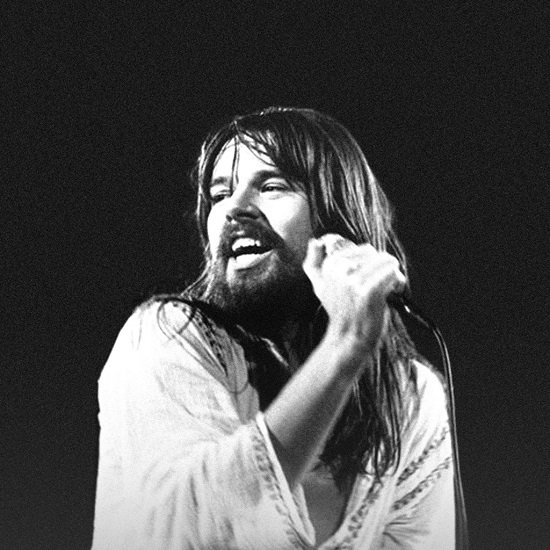
Here’s a strange coincidence that brings a bit of musical history solidly back into the present. I had almost finished this piece and was in the process of editing, stepping away from and tweaking when I felt the need to go and photograph some live musicians again. On most Sundays during the summer months, you can catch some solo performers and duos at Eccleston Yards near Victoria Station in London. The gigs are organised by Talentbanq, a company that promotes unsigned musicians, mainly in small venues and you can usually find its hands-on CEO Ray Jones there as compere and sound engineer. The first performer on stage was Erin Bowman, from New Jersey via California, playing a mixture of classic rock interpretations and original material. I was hooked from the start by her laid-back acoustic version of Tom Petty’s “American Girl”, but the last song in the set was the one that did it. In London, in 2021, Erin was doing her version of Bob Seger’s “Against the Wind”, originally released in 1980. Never underestimate the staying power of a great song.
If you’ve been seriously into music for over fifty years, then you’ve had an artist (or a few) that got away. The ones you were convinced would be massive but didn’t make it at all, or only in certain territories. One of mine was Bob Seger, with or without The Silver Bullet Band. I knew he deserved be a UK Top 20 artist, but it took about twenty years to prove me right (sort of).
It’s been a long journey, but where did it start? Nottingham’s commercial station Radio Trent in 1974, I guess. I heard “Get Out of Denver” blasting out of a tiny radio speaker and I was hooked. No doubts, no second thoughts, this was the mutt’s. Was it a Chuck Berry rehash? Of course it was, but Chuck could never have written those lyrics and his laconic drawl wouldn’t have allowed him to fire and spit them out the way Bob Seger did. This was “Tulane” on steroids and I was hooked, although it would take a couple of years before I was finally reeled in.
Bob Seger spent years grinding round the Midwestern circuit building up a massive and loyal live following before first troubling the US singles charts in 1967 and 1968 respectively with “Heavy Music” and “Ramblin’ Gamblin’ Man” which both went on to become huge live favourites. He was a classis seventies example of building up a live fanbase to help (eventually) sell records. During the period between ‘68 and ’75, his band went through personnel and name changes and moved from Capitol to Reprise and back again. Reprise had tried to break him through into the mainstream, even trying to break the UK, but they were only reaching musicians and the committed (“Get Out of Denver” was covered by Eddie and the Hot Rods and Dave Edmunds and “Rosalie” was covered by Thin Lizzy). So back to Capitol again.
What happened next was really interesting. The first Capitol album, “Beautiful Loser” was the blueprint for what was to come over the next ten years. It was a combination of up-tempo rockers (“Katmandu”) and slower, more nostalgic pieces (“Fine Memory” and “Momma”), the well-chosen cover (“Nutbush City Limits”) and the classic wistful mid-tempo pieces (“Beautiful Loser” and “Jody Girl”). Its peak chart position in the US was 131, but it went on to hit double platinum certification. It wasn’t perfect, but everyone involved knew that this was the template; more of the same would do very well indeed, but there was a way of building up a head of steam before the next studio album. The mid-70s was the era of the double live album; if you had a band that could reliably turn it on live and you put them in front of a friendly crowd you had an instant hit, so that’s what Capitol did.
“Live Bullet” was the clincher; a classic example of a live band at their peak. You got Bob Seger originals, including the classic-to-be “Turn the Page” (later covered by Metallica) and covers of “Nutbush City Limits” and “Let It Rock”. It went quintuple platinum in the US and now no-one was looking back. In the space of a year Bob Seger had arrived, at least in the US. It was always a mystery to me that no-one else in the UK seemed to get this but, with hindsight, it was just too American for the time. In 1975 Bob Seger stood a chance of being bracketed with the better bands breaking out from the pub rock scene, but was doomed in the UK after the insular and inward-looking punk explosion. It wasn’t stopping me; I grew up in a town where any sort of escape, to London or Detroit, was a good thing. And if I’m honest, the inner music snob in me likes to support an artist/band that no-one else has heard of.
As far as the North American continent (and later, Australia) were concerned, Bob Seger had made it. In the US alone, he sold over 30 million albums between 1975 and 1991, and that’s people who went to their local record shop and parted with cash for vinyl, cassette, eight track (remember that) and, towards the end, CD. The stars had aligned; the formula for the albums had been established with “Beautiful Loser”, the songwriting was perfectly honed, the production was superb (and don’t underestimate the importance of the backing vocalists from “Night Moves” onwards), Capitol was 100% behind the artist and The Silver Bullet Band was the perfect vehicle to go out and sell the songs to a live audience. Between 1975 and the peak, when “Against the Wind” hit Number One in the US album charts in 1980, Bob Seger could do no wrong in his home territory, Australia and big chunks of Europe, so why not the UK? Two obvious reasons.
The first one is about economics. Despite a reasonable amount of radio play, only the albums “Stranger in Town” and “Against the Wind” made any impact on the album charts and the singles did even worse. It was the wrong kind of music for the UK at that time despite being huge across the pond. It didn’t really make any economic sense for Capitol/EMI to invest huge amounts in touring the UK if it didn’t significantly add to record sales, and they were probably right. The Silver Bullet Band only played five gigs in Britain and I was at two of those; Glasgow Apollo (14/10/77) and Wembley Arena (21/11/1980). I’m slightly biased, but both were stunning gigs that were well-attended by wildly enthusiastic audiences and they were his first and last UK gigs. Unfortunately, you couldn’t break the UK market with five gigs. If you were counting the beans at Capitol/EMI, why would you invest any more in a territory like the UK when you could tour arenas in the USA and Canada promoting new albums and selling shedloads of merchandise. I understand that completely.
The second point is a bit more controversial, and more stalwart Bob Seger fans might want to stop reading now. I’m still a huge fan, but I couldn’t honestly say that there was one album that I wouldn’t want to skip an odd track on (with two exceptions, coming later). From 1975 onwards, Capitol/EMI were pitching Bob Seger at the traditional album market and they didn’t seem to see that the material wasn’t always even. “Night Moves”, “Stranger in Town” and “Against the Wind” had more than their fair share of classic songs, but they weren’t consistent or consistently excellent. You want reasons for that? Pressure to write brilliant new songs for albums every eighteen months while touring constantly, using the Silver Bullet Band for part of each album and The Muscle Shoals Rhythm Section for the other part, or maybe just burnout. The albums had to keep appearing regularly to satisfy the public, whether they were perfect or not. After “Against the Wind”, sales started to slow and gaps between albums increased as Seger’s family life became more important. And that should have meant the last chance for UK success, but you never know, do you?
In the summer of 1996, I was in the Pub on the Pond in Swansea having lunch with my mate Bekky when I heard a familiar voice from the CD jukebox (remember them?). It was Bob Seger and I had to go over and check it out, because it wasn’t a song I’d heard him play. It was a storming cover of the Chuck Berry classic “C’est la Vie”/”You Never Can Tell” and the album was “Greatest Hits”, released in the UK in 1994 which sort of proved my theory that Bob Seger had a huge number of classic songs but they weren’t all on the same album. It reached Number 6 in the UK and also spawned the first UK Top 40 single with “We’ve Got Tonite”. It probably helped that the songs were all FM radio-friendly and continued to be played on pockets of UK radio long after their initial release. There was a certain irony that Brits nostalgic for the 70s were buying into an album that was packed with nostalgia for 1950s/60s America. It’s a near-perfect album and the UK marketing worked like a dream.
There was another Seger album I would happily listen to all the way through, and it was intended to be the swansong. “Ride Out” was released in 2014 and it would have been a fitting famous final scene; it’s a classic album that I would recommend to anyone. Only it wasn’t the final album; as a response to the death of his long-time friend from Detroit, Glenn Frey in 2016, he released one final album, “I Knew You When” as a tribute, in 2017. That was the second encore and Bob Seger had finally left the building.
As a long-time fan, it was a validation that he finally achieved success in the UK even if it was a little late. If the run of albums starting with “Night Moves” had started a year earlier or five years later, things might have been very different, but it won’t keep him awake at night – he sold over 75 million records worldwide, wrote songs that were covered by almost everyone (there are over sixty covers of “We’ve Got Tonite”) and finished his career on his own terms. He wrote classic songs that we could all relate to and, if “Against the Wind” isn’t played at my funeral, will you all please deal with the people responsible. If you already know his work, you’ll probably understand why I’ve written this; if not, you could do a lot worse than check him out anyway. Rock and roll never forgets.
 This is the final album review of the strangest year I’ve had in a very, very long time. It’s quite unusual to release albums of original material in December; it’s normally a time for retrospectives, compilations and TV personalities singing Christmas songs. This year, however, all bets are off as the virus has closed so many doors while opening a few new ones. Musicians have been adapting to a rapidly-changing environment throughout this century, so what’s the big deal about a pandemic? Home studios have been with us for a long time and it’s routine now to share huge audio files online; you can make an album with dozens of musicians without ever meeting them.
This is the final album review of the strangest year I’ve had in a very, very long time. It’s quite unusual to release albums of original material in December; it’s normally a time for retrospectives, compilations and TV personalities singing Christmas songs. This year, however, all bets are off as the virus has closed so many doors while opening a few new ones. Musicians have been adapting to a rapidly-changing environment throughout this century, so what’s the big deal about a pandemic? Home studios have been with us for a long time and it’s routine now to share huge audio files online; you can make an album with dozens of musicians without ever meeting them.
The album “Mayone”, by songwriter and multi-instrumentalist Steve Mayone, has a couple of reference points. The uncertainty generated by COVID 19 gave the Steve the impetus to get this album together, and the first Paul McCartney solo album “McCartney” (fifty years old this year) gave him the inspiration. The parallels between the two aren’t just around the experience of working alone in the studio alone as therapy; Steve has echoed the ebb and flow of Paul McCartney’s album, and some of the themes as well (more about that later).
The first listen to this album left two lasting impressions; that it was a guitar player’s album and that it had a very seventies feel. Before reading the press release, I felt that the album had the feel of a solo Beatles project (right) and that the solo Beatle was George Harrison (wrong). It’s definitely a guitar player’s album, though; there are multiple layers of acoustic and electric guitars throughout the album, with the additional spicing of mandolin, banjo, ukulele and lap steel. I’m sure one of Steve’s aims was to make people revisit “McCartney”; it worked in my case and I’m recommending it to you as well.
“Mayone” has thirteen tracks (as does “McCartney”) and mixes up instrumental soundscapes with some beautifully-crafted songs. The instrumentals are perfect little vignettes scattered across the album, starting with the finger-picked acoustic, “The Sweet Suzanne” referencing McCartney’s “The Lovely Linda” even down to the alliteration in the title; Steve Mayone is paying serious attention to detail here.
There’s a huge variety to the songs here, from the no-prisoners-taken rock of “Sweet Little Anchor”, hinting at Bob Seger and Tom Petty to the melancholy “Airport Goodbyes” and the archetypical Christmas song (with an ironic drunken stupor twist), “Happy Alcoholidays”. These are all great songs but the perfect McCartney match is still to come. “Stuff” is a takedown of consumerism on a personal and global level that moves McCartney’s “Junk” on by fifty years, but Steve takes it a stage further. The McCartney “Junk” appears in a vocal version on track six and as “Singalong Junk” (an instrumental) on track eleven; guess the track sequencing of the “Stuff” vocal and instrumental on Steve’s album?
Steve Mayone has created an album of material that’s totally original, while cleverly referencing and emulating McCartney’s “McCartney”. “Mayone” is a 2020 classic; let’s hope it lasts as long as “McCartney”.
“Mayone” is released in the UK on Friday December 18th on Mayone Music.
 It’s heart-breaking to see so many press releases at the moment that tell that a band or artist will be touring to support their new album. This stuff is planned months ahead, and longer, to coincide with the album coming out. The press release for “Blue Sky” refers to band touring through 2020 to promote the album; even with Trump’s best bluster, that’s unlikely to happen now, so one of the few things to do is look out for the good reviews and make sure that you get them out there. But I’m sure that The Reverend Shawn Amos will have that under control, because of his background in digital marketing (among other things). Ok, here’s another one for you.
It’s heart-breaking to see so many press releases at the moment that tell that a band or artist will be touring to support their new album. This stuff is planned months ahead, and longer, to coincide with the album coming out. The press release for “Blue Sky” refers to band touring through 2020 to promote the album; even with Trump’s best bluster, that’s unlikely to happen now, so one of the few things to do is look out for the good reviews and make sure that you get them out there. But I’m sure that The Reverend Shawn Amos will have that under control, because of his background in digital marketing (among other things). Ok, here’s another one for you.
In a career that’s been characterised by fairly dramatic shifts, “Blue Sky” is no exception. After embracing the broad church of blues, Shawn Amos had very little interest in writing; he wanted to sing and play harmonica. Things changed, however, after his move to Texas from California and a long-term commitment to The Brotherhood (Brady Blade – drums, Christopher Thomas – bass, and Chris ‘Doctor’ Roberts – guitar); he’s also totally committed to writing now as well as performing.
The album’s opening song, “Stranger Than Today”, feels like a bridge between California and Texas. The styling is pure West Coast (synthetic beats aside) although the subject matter is pure blues; the life and death of Little Walter, blues harmonica innovator. And from there on in, it’s blues in its many hues, from the heartbreak blues of “Her Letter” through the New Orleans, gospel settings of “The Job is Never Done” to the straightforward jump blues of “27 Dollars”, harking back to KC Douglas’ “Mercury Blues”, with the theme of buying a Coupe De Ville at all costs. Other highlights include the uptempo rock of “Hold Back”, hinting at the driving Seventies sound of Bob Seger and the Silver Bullet Band and the album’s closing song “Keep the Faith, Have Some Fun”, which is simply structured, but throws in everything, including Latin horns and gospel call and response vocals.
“Blue Sky” covers most of the blues spectrum from dark, swampy Southern blues to uptempo horn-driven Latin-tinged blues. It’s a collection of great players working together to make great music with a strong political agenda, led by a charismatic and committed frontman. Give it a listen.
“Blue Sky” is out in the UK now on Put Together Music (PTM-00008).
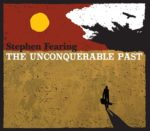 Stephen Fearing’s thirteenth solo album’s very personal and, at the same time it’s also political, but this isn’t just one for the social theorists because those elements are inextricably linked with the musical settings for the songs. Three of the songs on the album are named for people and there’s a strong vein of nostalgia running through the lyrical and musical stylings of “The Unconquerable Past”, although this isn’t by any means wallowing in the past; it’s much more of a realisation that there’s always a danger of dismissing older musical styles as no longer relevant in the headlong rush to be on-trend. It’s not a new thing, those wonderful old cynics Becker and Fagen nailed it in their own beautifully sleazy way in “Hey Nineteen” in 1980: ‘Hey, nineteen, that’s ‘Retha Franklin, she don’t remember the Queen of Soul’.
Stephen Fearing’s thirteenth solo album’s very personal and, at the same time it’s also political, but this isn’t just one for the social theorists because those elements are inextricably linked with the musical settings for the songs. Three of the songs on the album are named for people and there’s a strong vein of nostalgia running through the lyrical and musical stylings of “The Unconquerable Past”, although this isn’t by any means wallowing in the past; it’s much more of a realisation that there’s always a danger of dismissing older musical styles as no longer relevant in the headlong rush to be on-trend. It’s not a new thing, those wonderful old cynics Becker and Fagen nailed it in their own beautifully sleazy way in “Hey Nineteen” in 1980: ‘Hey, nineteen, that’s ‘Retha Franklin, she don’t remember the Queen of Soul’.
To come back to Stephen Fearing, this album is a bit of a departure from his solo material in that, at times, there’s a full rock band behind some uptempo tunes, one of which, “Christine”, goes way back to classic rockabilly styling and it’s a lot of fun. The other notably uptempo song, “Stay with Me” has its roots firmly in drivetime rock that Bob Seger seemed to knock out for fun in the late seventies.
If there’s one theme above all others pulling the album together it’s empathy, particularly where people with differences are dealing with harsh and unforgiving society we live in today. “Sunny” is a great example as the story is gradually revealed of a transgender individual leaving home to eventually find a relationship that works. The writer isn’t judging, and preaches the same tolerance in “Someone Else’s Shoes”; we should always try to understand the pressures someone else is facing rather than rushing to condemn.
Personal highlights are the poignant “Emigrant Song”, co-written with Andy White, dealing with the conflicting tensions of moving and looking back at happy memories, and the title song, with the message that we are products of our past but we don’t have to be defined by it. The album closes out with “No Country”, a solo acoustic ballad that positions the troubadour as a citizen of nowhere at all.
“The Unconquerable Past” is a collection of ten high-calibre songs performed with quality and taste that will make you tap your feet and make you stop and think. Not a bad combination.
“The Unconquerable Past” is out in the UK now in various physical and digital formats of Fish Records (FRCD03).
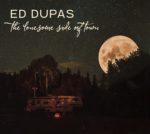 It’s fair to say I’m not a prolific reviewer; it’s all about the process. The first listen to an album decides whether it moves me enough to review it, then it gets another five or six listens before I make some notes, track by track. Then I look at the press release and lyric sheets, sleeve notes and anything else that came with the songs. It’s just the way I do it and it throws up some interesting little insights. And there are some artists that you look forward to reviewing because they always make you think very carefully about their work; Ed Dupas is one of those artists. He writes a lot of songs about relationships, happy or sad, but you know that each album will have one song that digs deep and pulls out a reaction to the world that surrounds us. We’ll get to that in a while.
It’s fair to say I’m not a prolific reviewer; it’s all about the process. The first listen to an album decides whether it moves me enough to review it, then it gets another five or six listens before I make some notes, track by track. Then I look at the press release and lyric sheets, sleeve notes and anything else that came with the songs. It’s just the way I do it and it throws up some interesting little insights. And there are some artists that you look forward to reviewing because they always make you think very carefully about their work; Ed Dupas is one of those artists. He writes a lot of songs about relationships, happy or sad, but you know that each album will have one song that digs deep and pulls out a reaction to the world that surrounds us. We’ll get to that in a while.
Most of the songs on “The Lonesome Side of Town” fall into genres that can be labelled as country, rock or some combination of the two. Country’s the dominant force on this album with arrangements featuring pedal steel, lap steel, banjo and resonator, but the addition of a Hammond B3 adds another dimension, taking the sound into The Band territory. And let’s not forget the Merseybeat feel of “Love Me Right”, with its chiming guitars and sus4 chords.
Of the eleven songs, ten are deeply personal, dealing with aspects of a relationship breakdown and one, “State of the Nation”, placed in the dead centre of the album, is the zeitgeist song. Ed Dupas doesn’t do a lot of these, but when he does, they hit, and they hit hard. “State of the Nation” is an out-and-out rocker about the divide between the people who work and the people who benefit from that work. It’s no frills rock ’n’ roll fired out in less than three minutes and it brings to mind Bob Seger’s 1978 song “Feels Like a Number” – well, Ed does live in Ann Arbor, Michigan. As an example of the level of detail in the production, rather than crashing the over-driven guitar in at the beginning of the second verse, it’s faded in just before the beginning of the verse so that it reaches the right level just as the verse begins; just a little touch, but it works perfectly.
But that’s not to belittle the rest of the album. The title song sets the mood for the album as it tells the familiar story of a relationship with a performer, while “It All Sounds like Leaving” could only ever be a country song, particularly with the line ‘Let’s get on with the grieving, cos it all sounds like leaving’. Ed admits to agonising over the track order and losing one song that didn’t fit, and that confirms the message that it more than just a bunch of songs – it’s an album and there are subtle links between the songs. There are three references to ‘within’ or ‘between the lines’ and “On my Way” refers back to “It All Sounds like Leaving”. The more you dig, the more you find.
“The Lonesome Side of Town” is a beautifully-crafted set of songs coming out of a difficult situation. There are songs of heartache, a song of anger and some songs of redemption and moving forward. They are all songs of passion.
“The Lonesome Side of Town” is released in the UK on Friday October 25th on Road Trip Songs.
 As ever; songs, not singles. These songs are all from albums that we’ve reviewed this year (that’s Stone Foundation ruled out again – sorry guys). There’s something else, apart from greatness, that links all these choices; they’re not the only songs from the albums they feature on that could have made this list. The albums are all wonderful pieces of work taken as a whole, but they all feature at least two standout tracks that would have been seen as singles in a different musical era. There were difficult choices but ultimately it had to be whittled down to five songs. In no particular order, here are Allan’s favourite five songs of the year; the songs that made his heart soar or made him cry, but definitely made him hit the repeat button.
As ever; songs, not singles. These songs are all from albums that we’ve reviewed this year (that’s Stone Foundation ruled out again – sorry guys). There’s something else, apart from greatness, that links all these choices; they’re not the only songs from the albums they feature on that could have made this list. The albums are all wonderful pieces of work taken as a whole, but they all feature at least two standout tracks that would have been seen as singles in a different musical era. There were difficult choices but ultimately it had to be whittled down to five songs. In no particular order, here are Allan’s favourite five songs of the year; the songs that made his heart soar or made him cry, but definitely made him hit the repeat button.
Just to be contrary, it’s actually the first song on the album, ”Southern Wind”, which was a collaboration with Will Kimbrough. One of the things Dean and Will bonded over was their love of Ronnie Lane, whose influence is all over this one. Having heard it live a few times, where it tends to appear towards the end of the set, confirms the power of the song and allows Dean to riff on repeated choruses by throwing in lines from, for example, “Ooh La La”. It’s fun and it’s memorable; if you don’t love this, you’ve got icicles for ventricles.
 “Love in Wartime” – Birds of Chicago
“Love in Wartime” – Birds of Chicago
Absolutely gorgeous. This clocks in at about the six minute mark but you just want it to keep going. It’s one of those that seduces you in with a gentle intro then builds and builds to the first chorus. And by that time, you’re hooked; you’re there for the duration. Maybe there’s a nostalgia thing there; the feel, the chord progressions are a lot like classic mid-seventies era Bob Seger. The melody’s hummable, the harmonies are superb and it’s hugely uplifting. I dare you not to be moved by this.
 “Out from Under” – Michael McDermott
“Out from Under” – Michael McDermott
This is a song where you just have to accept the Bruce Springsteen comparison because this is a stadium rocker in the mould of “Born to Run”. It’s a monstrous ‘wall of sound’ production driving along by pounding, relentless floor toms and a huge full band arrangement. In the context of the album, it’s the song that represents the start of the upward turn in Michael’s rehabilitation and the uplifting lyrical message is carried along on the tide of a widescreen musical setting. Taken out of the context of the album, it’s a song that FM radio in the States would have been all over in the 80s – not just a powerhouse arrangement, a potent message as well.
 “Son of an Immigrant” – Gerry Spehar
“Son of an Immigrant” – Gerry Spehar
A perfect example of the song that leads you in a certain direction before pulling the rug from under you and twisting the point of the narrative. It’s not just an example of a clever narrative trick; like the rest of the album, this is a powerful commentary on the current state of the USA, and its current leader. The song has a very clear message; if you go back far enough almost everyone’s an immigrant in the land of the free. Like “Out from Under”, it sits perfectly within the context of the album without needing that context to shine as a great song.
 “The Shape of You” – Rod Picott
“The Shape of You” – Rod Picott
Sometimes a song just needs to find the point in your life where it fits. This one happened for me on the Tube on the way back from a gig at Green Note. I’d already heard it a few times but this time it suddenly hit home. It’s about the realisation that someone has become a part of you. In this case because that person has gone, but I guess the image works if they’re still around. The song opens with the image in the title, then develops that image. It’s a really simple idea but beautifully effective. The arrangement’s sparse, with mainly acoustic guitar and vocal with some very subtle Will Kimbrough guitar atmospherics just lurking in the background. Delicate and gorgeous.
There are many other songs that could have been on this list; there’s so much incredible music out there, but these were the ones that were buzzing around my consciousness when I put this together. Have a listen, and I hope you enjoy.
 So, where would this little Ben Kunder gem sit in the racks of your local music store? It’s almost impossible to say but I guess it’s going to land in that current catch-all, the Americana section because it features that well-known roots instrument, the synthesiser. The lasting impression of the album is of positivity; the two words of the title cropping up across various songs. It certainly ends on a positive note with a celebration of the birth of a baby in “Night Sky”. Lyrically, the album falls squarely into the introspective singer-songwriter category, but the stylings vary dramatically across the nine songs; let me explain.
So, where would this little Ben Kunder gem sit in the racks of your local music store? It’s almost impossible to say but I guess it’s going to land in that current catch-all, the Americana section because it features that well-known roots instrument, the synthesiser. The lasting impression of the album is of positivity; the two words of the title cropping up across various songs. It certainly ends on a positive note with a celebration of the birth of a baby in “Night Sky”. Lyrically, the album falls squarely into the introspective singer-songwriter category, but the stylings vary dramatically across the nine songs; let me explain.
While “Fight for Time” “Better Days” and “Hard Line” fall in to fairly standard arrangements for this genre (okay “Hard Line” features a string section towards the end), “Jessi” has the feel of a eighties drive-time classic driven with some insanely catchy synth hooks thrown in for good measure. In common with the rest of the album, there are hints of Jackson Browne in the writing and the vocal intonation. “Lay Down”, however, is pure E Street Band with perhaps a few hints of Bob Seger in there as well. It’s over five minutes long and the combination of piano and organ from the beginning set the tone; maybe there are hints of The Band in there as well. As the song builds, no opportunity’s missed to gild this particular lily, with extra percussion from congas and tambourine, a falsetto vocal and a huge slide solo. The frantic drumming towards the end sums up the production; if it’s worth doing, it’s worth overdoing. “Come On”, which follows immediately, is a welcome chance to catch your breath before the album closes with the lovely “Night Sky”.
“Better Human” is an immensely uplifting album, focussing on the ways we can make things better for ourselves and each other. The fact that the sentiment is helped along by interesting and innovative arrangements lifts it well above the ordinary run of singer-songwriter albums.
“Better Human” is released on Comino Music (BKBH002) on Friday September 28th.
I’m not sure that the term ‘single’ means anything in music terms any more. Radio professionals talk about lead tracks from albums, but I’ve got to the point where I just call them great songs. Most of the albums I hear won’t actually have a physical single released from them; it’s twelve songs on iTunes or Spotify. So I’m not picking five favourite singles, I’m picking five favourite songs that I’ve heard for the first time this year, in no particular order.
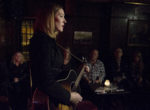 “Living on Lonely” – Hannah Aldridge – This song is from Hannah’s “Gold Rush” album, which was released this year. I’ve heard Hannah play the title song live over about eighteen months and I was convinced it would be my favourite song on the album (it’s a stunningly good song) but after hearing the album and hearing Hannah play the songs live this year, it’s “Living on Lonely” that has really made an impact. It’s a slow-paced piece dealing with the loneliness of life on the road and the inevitable temptations of that lifestyle. There’s some gorgeous low-register guitar running through the song and Hannah’s vocal is heart-rendingly melancholic. It’s just beautiful.
“Living on Lonely” – Hannah Aldridge – This song is from Hannah’s “Gold Rush” album, which was released this year. I’ve heard Hannah play the title song live over about eighteen months and I was convinced it would be my favourite song on the album (it’s a stunningly good song) but after hearing the album and hearing Hannah play the songs live this year, it’s “Living on Lonely” that has really made an impact. It’s a slow-paced piece dealing with the loneliness of life on the road and the inevitable temptations of that lifestyle. There’s some gorgeous low-register guitar running through the song and Hannah’s vocal is heart-rendingly melancholic. It’s just beautiful.
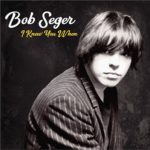 “I Knew You When” – Bob Seger – When he released “Ride Out” in 2014, it had the feel of a farewell to the music business and there were plenty of rumours that it was Bob Seger’s swansong, and maybe it was, at that time; it would have been a great album to bow out on. Everything changed on January 18, 2016 with the death of his good friend from Detroit, Glenn Frey. It’s taken a while to process, but he’s used the pain and love for his old friend to form the back bone of another great late career album. He’s always been a master of the mid-tempo rock song evoking late fifties early sixties smalltown America and “I Knew You When” is a perfect example of the style with the added poignancy of a personal connection.
“I Knew You When” – Bob Seger – When he released “Ride Out” in 2014, it had the feel of a farewell to the music business and there were plenty of rumours that it was Bob Seger’s swansong, and maybe it was, at that time; it would have been a great album to bow out on. Everything changed on January 18, 2016 with the death of his good friend from Detroit, Glenn Frey. It’s taken a while to process, but he’s used the pain and love for his old friend to form the back bone of another great late career album. He’s always been a master of the mid-tempo rock song evoking late fifties early sixties smalltown America and “I Knew You When” is a perfect example of the style with the added poignancy of a personal connection.
 “1954” – Hannah Rose Platt – This is one of those that grabbed me instantly: first play. I know it’s four years old, but 2017 was when I heard it first, so it’s going in. I love Hannah’s songs; she has a gift for melody and knows how to tell a story. This is based on a story told to her by a housemate about a care home patient who dressed up every evening to wait for a date that never arrived. Hannah relocated the story from Liverpool to America, added just enough detail to make it feel real and created a heart-breaking little masterpiece. I heard her play it live last weekend and it was just perfect. She has an album coming out in 2018 and I’m certain we’ll be reviewing it here.
“1954” – Hannah Rose Platt – This is one of those that grabbed me instantly: first play. I know it’s four years old, but 2017 was when I heard it first, so it’s going in. I love Hannah’s songs; she has a gift for melody and knows how to tell a story. This is based on a story told to her by a housemate about a care home patient who dressed up every evening to wait for a date that never arrived. Hannah relocated the story from Liverpool to America, added just enough detail to make it feel real and created a heart-breaking little masterpiece. I heard her play it live last weekend and it was just perfect. She has an album coming out in 2018 and I’m certain we’ll be reviewing it here.
 “Your Balloon is Rising” – Stone Foundation featuring Paul Weller – I have so much admiration for these guys. They’ve done it the hard way without any help (until this year) from the music establishment. They’ve written, recorded, gigged and written, recorded, gigged until they built up a substantial fanbase in the UK, Europe and Japan then suddenly Paul Weller was producing their latest album “Street Rituals” at Black Barn as well as co-writing and making guest appearances. Here’s one of those guest appearances on a beautiful soul ballad that’s absolutely timeless. Weller’s voice works with the song, but even without him it sounds just fine with a Neil Jones vocal.
“Your Balloon is Rising” – Stone Foundation featuring Paul Weller – I have so much admiration for these guys. They’ve done it the hard way without any help (until this year) from the music establishment. They’ve written, recorded, gigged and written, recorded, gigged until they built up a substantial fanbase in the UK, Europe and Japan then suddenly Paul Weller was producing their latest album “Street Rituals” at Black Barn as well as co-writing and making guest appearances. Here’s one of those guest appearances on a beautiful soul ballad that’s absolutely timeless. Weller’s voice works with the song, but even without him it sounds just fine with a Neil Jones vocal.
 “Tennessee Night” – Ed Dupas – I’m rapidly becoming a big fan of Ed Dupas as a songwriter and a singer. He has a passion for his craft and combines rock and country sounds in a way that reminds me a little of Bob Seger (coincidentally). “Tennessee Night” is the title song from his 2017 album and is a perfect little vignette that evokes “Texasville”, the sequel to “The Last Picture Show”, where the small-town girl returns from the big bad city and there might be a happy ending, or there might not. The answer’s left hanging in the Tennessee night. It’s a classic piece of songwriting from an artist with a true passion for his craft.
“Tennessee Night” – Ed Dupas – I’m rapidly becoming a big fan of Ed Dupas as a songwriter and a singer. He has a passion for his craft and combines rock and country sounds in a way that reminds me a little of Bob Seger (coincidentally). “Tennessee Night” is the title song from his 2017 album and is a perfect little vignette that evokes “Texasville”, the sequel to “The Last Picture Show”, where the small-town girl returns from the big bad city and there might be a happy ending, or there might not. The answer’s left hanging in the Tennessee night. It’s a classic piece of songwriting from an artist with a true passion for his craft.
If you use Spotify, give these songs a listen. They’re all worth it.
If you want to treat yourself or someone close to you to who’s a music fan to something interesting for Christmas, then we’ve got a few ideas for you. There are books, an album and a very interesting merchandising idea.
 Sound of the Sirens merchandising – I love Sound of the Sirens. Abbe Martin and Hannah Wood are incredibly talented writers and performers, but there’s a lot more to it than that. They attract like-minded people into their orbit and create friendships between fans from all over the country. They also have some interesting ideas about merchandising. Selling mugs is fairly standard, but why not take it a stage further and sell tea towels with a picture of the band. And what a great strapline: “Wipe your mugs with our mugs”.
Sound of the Sirens merchandising – I love Sound of the Sirens. Abbe Martin and Hannah Wood are incredibly talented writers and performers, but there’s a lot more to it than that. They attract like-minded people into their orbit and create friendships between fans from all over the country. They also have some interesting ideas about merchandising. Selling mugs is fairly standard, but why not take it a stage further and sell tea towels with a picture of the band. And what a great strapline: “Wipe your mugs with our mugs”.
 “Don’t You Leave Me Here: My Life” (book) – Wilko Johnson – Wilko has put together a memoir/autobiography that covers more than forty years in the music business, success, failure, cancer diagnosis and recovery, and coming to terms with his status as a legend. It’s a great fly-on-the-wall insight into the workings of bands and the music business and it’s well worth reading. I had a bit of a shock when I realised that the Solid Senders bass player who I had photographed in 1977 in Dundee was the same person I photographed playing bass in Phil Burdett’s band in Southend last year. Small world.
“Don’t You Leave Me Here: My Life” (book) – Wilko Johnson – Wilko has put together a memoir/autobiography that covers more than forty years in the music business, success, failure, cancer diagnosis and recovery, and coming to terms with his status as a legend. It’s a great fly-on-the-wall insight into the workings of bands and the music business and it’s well worth reading. I had a bit of a shock when I realised that the Solid Senders bass player who I had photographed in 1977 in Dundee was the same person I photographed playing bass in Phil Burdett’s band in Southend last year. Small world.
 “I Knew You When” (album) – Bob Seger – Another one of my teenage heroes who’s still around and still relevant. This album came out of the blue; his 2014 album “Ride Out” had the feel of an album that was closing out a career and it might have been his swansong but for a tragic event. His old friend from Detroit, Glenn Frey, died earlier this year and this album is largely inspired by their friendship. Sometimes it’s right in your face (the album cover, for example) and sometimes it’s a bit more subtle – the title track is classic mid-tempo Seger with no names mentioned, but it’s obviously about Glenn Frey. It’s sad that it took such a tragic event to kickstart the album, but wonderful to hear a hero still so fired up about social issues.
“I Knew You When” (album) – Bob Seger – Another one of my teenage heroes who’s still around and still relevant. This album came out of the blue; his 2014 album “Ride Out” had the feel of an album that was closing out a career and it might have been his swansong but for a tragic event. His old friend from Detroit, Glenn Frey, died earlier this year and this album is largely inspired by their friendship. Sometimes it’s right in your face (the album cover, for example) and sometimes it’s a bit more subtle – the title track is classic mid-tempo Seger with no names mentioned, but it’s obviously about Glenn Frey. It’s sad that it took such a tragic event to kickstart the album, but wonderful to hear a hero still so fired up about social issues.
 “Going on the Turn” (book) – Danny Baker – It’s the third volume of Danny Baker’s memoirs, covering events to the present day, including his battle with head and neck cancer and high profile local radio sacking. He’s a natural writer who always manages to find a unique twist on even the most difficult subjects. It’s a life-affirming book and it’s all based in the area I’m working in at the moment, which gives it a nice personal touch. It’s a great read.
“Going on the Turn” (book) – Danny Baker – It’s the third volume of Danny Baker’s memoirs, covering events to the present day, including his battle with head and neck cancer and high profile local radio sacking. He’s a natural writer who always manages to find a unique twist on even the most difficult subjects. It’s a life-affirming book and it’s all based in the area I’m working in at the moment, which gives it a nice personal touch. It’s a great read.
 “Some Fantastic Place” (book) – Chris Difford – There’s a link to the previous book; Danny Baker went to the same school as Chris and their careers have touched at many points. I’ve always been a massive fan of Squeeze and this is a fascinating insight into the fraught relationship between Chris and Glenn Tilbrook. He doesn’t try to pretend that he’s perfect (far from it) and the book’s all the better for that. The only criticism (if you’re a geek like me) is that it would have benefited from some more rigorous fact-checking. It’s still a fascinating read.
“Some Fantastic Place” (book) – Chris Difford – There’s a link to the previous book; Danny Baker went to the same school as Chris and their careers have touched at many points. I’ve always been a massive fan of Squeeze and this is a fascinating insight into the fraught relationship between Chris and Glenn Tilbrook. He doesn’t try to pretend that he’s perfect (far from it) and the book’s all the better for that. The only criticism (if you’re a geek like me) is that it would have benefited from some more rigorous fact-checking. It’s still a fascinating read.


 “The Last Song” – Dean Owens
“The Last Song” – Dean Owens